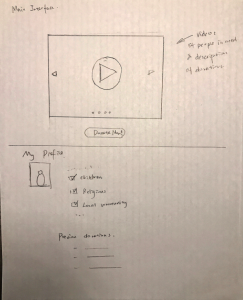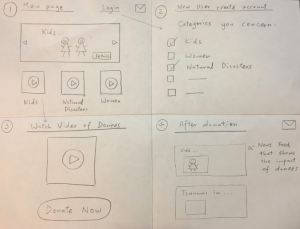Blog Update #2a: Next Steps
The next steps of the development will be generating low-fi/medium-fi prototypes and determine a proper experimental design to explore our findings further. Given the limited time and resources, we will focus on some of the key findings from our study. According to our interviews, all participants cited that internal factors such as empathy are the most important factors of motivating them to donate. External factors are relatively trivial and some external factors such as people who are pushy or intrusive may even hinder them from donating. Most participants tend to donate to causes that really touch them such as the difficulties of people in need. Therefore, we will be focusing on spurring people to donate by appealing to arousing their emotions. Additionally, there is a tendency for people to donate for causes they care about or mostly related to their personal experience. Our system will also focus on matching people’s interests with opportunities for donations.
We found that the lack of trustworthiness is a barrier that hinder people from donating. And most participant evaluate the trustworthiness of an charitable organization according to their familiarity and transparency of information. Additionally, one thing in current practices our users complained the most is that organizations do not always feedback, and we found providing feedback would promote long-term donations. Therefore, Our system will aim to motivate donations by improving the exposure of the donation information and providing feedback.
Moving forward we plan to explore different approaches/design alternatives to help us to address findings from our field study. We will explore different ways of arousing emotions of users and different formats to provide information and feedback to users. Hopefully we will help to address motivating long-term donations.
Blog Update #2b: Revised Task Examples
Summary of Changes:
Raymond:
– We changed the background of Raymond to be a more realistic person that is willing to do donations since we didn’t have a chance to interview any rich entrepreneurs that are also interested in donations.
– We pointed out the importance of feedback and the progress from charity after donors’ donations which will increase donor’s motivation.
Bella:
– We changed to point out the reason of Bella’s personality of caring others.
– Focused on the trustworthiness between individual and charitable organization.
Bob:
– Since we want to focus on increasing the motivation of donation behavior, we have changed this task example from a charity to a donor.
– We pointed out the fact that some donors are only motivated to donate to people who are related to them, and they need charity to remind them of the donation events that they are interested to donate.
Task Example 1: Raymond
Raymond is a university graduate, he is 27 years old and has worked as an Engineer for 3 years. Raymond cares about people and he intends to donate some portion of his income to help those who are in need. However, he is concerned about where his money goes to and the impact of his donation. He is a frequent donor and is especially motivated when he sees the stories of the donees and how hard their situation are. Most of Raymond’s donations go towards organizations he just so happened to stumble upon – for example, from street posters, or from social media content on the Internet. However, some of these organizations are really busy, and often don’t have enough feedback on the progress afterward or personal touch to their donors, so Raymond feels a bit more isolated and less connected that reduces his motivation to donate. He wants to establish a long-term donor-to-donee relationship with these organizations and wishes that there was some way that he could keep up to date with how he can help, and how his contributions have made a difference to those in need.
Task Example 2: Bella
Bella is a 20-year-old college student. She has an awareness about “helping others is a virtue” which is influenced by her family. This let her becomes a very charitable person that has much concern about people who need help. In the past, if she saw any organization was doing fundraising on the street and those charity workers came to her for donation, she was always willing to donate money to them. However, many news showed that some organization doing fundraising was just a fraudulent trick. She felt conflicted as the way she contributed was surprisingly not her original intention, and these destroyed her trustworthiness on those organizations. This changed her way to do donation. She only wants to donate to the charitable organizations recommended by her friends and family.
Task Example 3: Bob
Bob is a 35-year-old accountant and has moved to another country due to his job assignment. He is a person who only cares about the things or people who are related to him. Everytime he sees a charitable organization doing fundraising and asks him if he can donate some money for people in need, it does not motivate him to donate since he does not know who the donees are and he feels that it is not part of his business. In fact, sometimes he feels annoyed at those charity workers, as they are sometimes pushy and get in his way. Last month, he saw a news report about a natural disaster that happened in his hometown and there was an organization doing fundraising for helping those people in need. This disaster is related to his hometown, so it caused him to have a motivation to do the donation. He decided to do the donation after he get home from work. However, he totally forgot to do the donation when he got home, and
Blog Update #2c: Prioritized list of requirements
a) Absolutely must include
These requirements represent the major factors that can motivate donors to donate and are the most common concerns of donors after they make a donation. In addition, these requirements require more user testing and refinement than other requests.
– System includes ways that can appeal to the emotion of donors during the whole donation process.
– System includes a way to categorize different kinds of donation based on people’s interests.
– System includes a way for donors to know where their money goes to and the result of their donation.
– System includes an easy to use and clear flow when going through the process of donating.
b) Should include
This requirement is also very important to donors according to our field study but are slightly less important because they require a longer time for user testing to observe the effect.
– System includes a way for donors to establish a long-term donor-to-donee relationship with charity.
– System includes an easy way to remind the donation event that the donors are interested in.
c) Could include
This requirement is less important because donors tend to donate to charities that has established for a long time and/or are recommended by their family or friends, which does not require much user testing.
– System includes a way to show their trustworthiness to donors.
d) Could exclude
This requirement is a great addition to our system but is currently out of scope.
– Algorithms that can suggest categories of donation that are potentially interested by the donor.
Users: Must include
– Individuals who are (at least, somewhat) interested in donating to charities
– Individuals with enough knowledge to navigate a web interface
– Individuals who are able to pay by the payment methods provided
Users: Exclude
– Technologically illiterate people
– Illiterate people
– Individuals who are not interested at all in donations
Blog Update #2d: Design Alternatives
Design Alternative I: Donation Events

Description:
We envision a system that revolves around different types of “donation events”. These donation events are essentially fundraising campaigns organized by various charities with the goal to raise a certain amount of money for a specific cause. On the main interface of a donation event, there’s a large video which is used to introduce the donation event and arouse user emotion. We might also envision having some kind of progress bar to indicate the amount of money donated thus far.
Users have the option to create an account and set up a personal profile. Their profile stores information about categories of donation events that they are interested in, so that these can then be recommended to a specific user, personalizing the process.
Pros:
– Video is likely to be a stronger form of communication to arouse people’s sympathy
– Donation events give users a goal to reach and spur excitement around a cause.
Cons:
– Usefulness of system is dependent on number and diversity of events.
– Requires charities to host events and to include videos and relevant information.
Design Alternative II: Donation Gallery

Description:
In the main page of our system, we will show posters about the stories of donees who are in need, similar to that of a poster/photo gallery. Users can swipe to see more posters and click the “Details” button which direct them to the videos of donees if they are interested to know more about it. At the bottom of the posters, we will also show videos of donees to attract the attention of users.
If the user does not have a user account, he can create one and choose the categories of donation that he is interested. The latest posters and videos shown on the main page will be personalized by the categories chosen by the donees. When users click the video, he will be redirected to another page that has a huge “Donate Now” button to encourage one to donate. It makes it easy for the user to know the next step to do if he want to donate. After a user has donated, he can check his message box to know about the update of his donation. News feed with photos and/or videos will be shown to tell the donor about the result and impact of his donation.
Pros:
– Catch user’s attention by using pictures and videos of donees on the main page
– Use of videos to appeal to user’s emotion
– Provide feedback to donors about the result and impact of their donation
Cons:
– Users can only choose a category to donate according to the posters/videos posted
– Require charity to film video only
– Nowhere to see detail information about the charity.